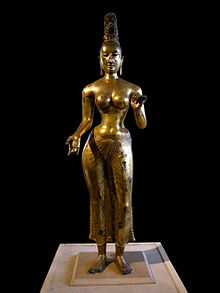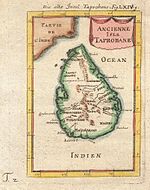Anuradhapura period
| Anuradhapura period | |||
|---|---|---|---|
| 377 BCE – 1017 | |||
 Gilded bronze statue of the Bodhisattva Tara, dated to the 8th century, found in the eastern coast of Sri Lanka | |||
| Including |
| ||
| Monarch(s) | |||
Chronology
| |||
| History of Sri Lanka | ||||||||||||||
|---|---|---|---|---|---|---|---|---|---|---|---|---|---|---|
 | ||||||||||||||
| Chronicles | ||||||||||||||
|
||||||||||||||
| Periods | ||||||||||||||
|
||||||||||||||
| By Topic | ||||||||||||||
|
||||||||||||||
The Anuradhapura period was a period in the history of Sri Lanka of the
Overview
Periodization of Sri Lanka history:
| Dates | Period | Period | Span (years) | Subperiod | Span (years) | Main government |
|---|---|---|---|---|---|---|
| 300,000 BP–~1000 BC | Prehistoric Sri Lanka | Stone Age
|
– | 300,000 | Unknown | |
| Bronze Age | – | |||||
| ~1000 BC–543 BC | Iron Age
|
– | 457 | |||
| 543 BC–437 BC | Ancient Sri Lanka | Pre-Anuradhapura | – | 106 | Monarchy | |
| 437 BC–463 AD | Anuradhapura | 1454 | Early Anuradhapura
|
900 | ||
| 463–691 | Middle Anuradhapura
|
228 | ||||
| 691–1017 | Post-classical Sri Lanka | Late Anuradhapura
|
326 | |||
| 1017–1070 | Polonnaruwa | 215 | Chola conquest | 53 | ||
| 1055–1232 | 177 | |||||
| 1232–1341 | Transitional | 365 | Dambadeniya
|
109 | ||
| 1341–1412 | Gampola
|
71 | ||||
| 1412–1597 | Early Modern Sri Lanka | Kotte
|
185 | |||
| 1597–1815 | Kandyan | – | 218 | |||
| 1815–1948 | Modern Sri Lanka | British Ceylon | – | 133 | Colonial monarchy | |
| 1948–1972 | Contemporary Sri Lanka | Sri Lanka since 1948 | 76 | Dominion | 24 | Constitutional monarchy |
| 1972–present | Republic | 52 | Unitary semi-presidential constitutional republic |
Political history
Early Anuradhapura period (377 BCE-463 CE)
Arrival of Buddhism and the sacred tooth relic
Middle Anuradhapura period (463-691)
Late Anuradhapura period (691-1017)
Lambakanna
Demise
In 993, the Chola Emperor Rajaraja I invaded Sri Lanka, forcing the then Sri Lankan ruler Mahinda V to flee to the southern part of the country.[1] The Mahavamsa describes the rule of Mahinda V as weak, and the country was suffering from poverty by this time. It further mentions that his army rose against him due to lack of wages.[2] Taking advantage of this situation, Rajendra I son of Rajaraja I, launched a large invasion in 1017. Mahinda V was captured and taken to India, and the Cholas sacked the city of Anuradhapura. They moved the capital to Polonnaruwa and subsequent Sri Lankan rulers who came into power after the Chola reign continued to use Polonnaruwa as the capital, thus ending the Anuradhapura Kingdom.[1]
Demographics
Arrival of Tamils
Technology
The irrigation works in ancient
Monarchs
The House of Vijaya, The Five Dravidians, House of Lambakanna I, The Six Dravidians, House of Moriya and the House of Lambakanna II produced 122 monarchs who ruled during this period.
Timeline
Events
- 377 BCE: The Anuradhapura Kingdom is founded by Pandukabhaya
In popular culture
- The God King, 1974 English and Sinhala historical film
- Aba, 2008 Sinhalese historical film
- Mahindagamanaya, 2011 Sinhalese historical film
- Aloko Udapadi, 2012 Sinhalese historical film
- Siri Daladagamanaya, 2014 Sinhalese historical film
- Maharaja Gemunu, 2015 Sinhalese historical film
- Mahaviru Pandu, 2020 Sinhalese drama by Hiru TV
- Asirimath Dalandagamanaya, 2022 Sinhalese drama by Hiru TV
See also
- Sinhala Kingdom
- List of Sinhalese monarchs
- Architecture of ancient Sri Lanka
Notes
References
Citations
- ^ a b Siriweera 2004, p. 44.
- ^ Wijesooriya 2006, p. 114.
- ^ Mahadevan 2003, p. 48.
- ^ Indrapala 2007, p. 157.
- ^ Mahadevan 2000, p. 152–154.
- ^ Bopearachchi 2004, p. 546–549.
- ^ De Silva 1981, p. 30–32.
Bibliography
- De Silva, K. M. (1981). A history of Sri Lanka. ISBN 978-0-520-04320-6.
- Mahadevan, Iravatham (2003). Early Tamil epigraphy from the earliest times to the sixth century A.D. Cre-A. ISBN 9780674012271.
- von Schroeder, Ulrich. 1990. Buddhist Sculptures of Sri Lanka. 752 pages with 1610 illustrations. Hong Kong: Visual Dharma Publications, Ltd. ISBN 962-7049-05-0
- von Schroeder, Ulrich. 1992. The Golden Age of Sculpture in Sri Lanka. [Catalogue of the exhibition held at the Arthur M. Sackler Gallery, Washington, D. C., 1 November 1992 – 26 September 1993]. 160 pages with 64 illustrations. Hong Kong: Visual Dharma Publications, Ltd. ISBN 962-7049-06-9
- Bandaranayake, Senake (2007). Sigiriya. Central Cultural Fund. ISBN 978-955-613-111-6.
- Bopearachchi, Osmund (2004). "Ancient Sri Lanka and Tamil Nadu". In Chevillard, Jean-Luc; Wilden, Eva (eds.). South-Indian Horizons: Felicitation Volume for François Gros on the occasion of his 70th birthday. Publications du Département d'Indologie – 94. Pondicherry: Institut Français de Pondichéry / École Française d'Extrême-Orient. pp. 546–549. ISSN 0073-8352.
- ISBN 978-955-1266-72-1.
- Lokubandara, W. J. M. (2007). The Mistique of Sigiriya — Whispers of the Mirror Wall. Godage International Publishers. ISBN 978-955-30-0610-3.
- Mendis, Ranjan Chinthaka (1999). The Story of Anuradhapura. Lakshmi Mendis. ISBN 978-955-96704-0-7.
- Perera, Lakshman S. (2001). The Institutions of Ancient Ceylon from Inscriptions. Vol. 1. International Centre for Ethnic Studies. ISBN 978-955-580-055-6.
- Rambukwelle, P. B. (1993). Commentary on Sinhala Kingship — Vijaya to Kalinga Magha. Sridevi Printers. ISBN 978-955-95565-0-3.
- Siriweera, W. I. (2004). History of Sri Lanka. Dayawansa Jayakodi & Company. ISBN 978-955-551-257-2.
- Siriweera, W. I. (1994). A Study of the Economic History of Pre Modern Sri Lanka. Vikas Publishing House. pp. 44–45. ISBN 978-0-7069-7621-2.
- Wijesooriya, S. (2006). A Concise Sinhala Mahavamsa. Participatory Development Forum. ISBN 978-955-9140-31-3.
- Paranavithana, Senarath (July 1936). "Two Royal Titles of the Early Sinhalese, and the Origin of Kingship in Ancient Ceylon". Journal of the Royal Asiatic Society of Great Britain and Ireland (3): 443–462.
- Mahadevan, Iravatham (March 2000). "Ancient Tamil Coins from Sri Lanka". Journal of the Institute of Asian Studies. XVII (2): 147–156.
